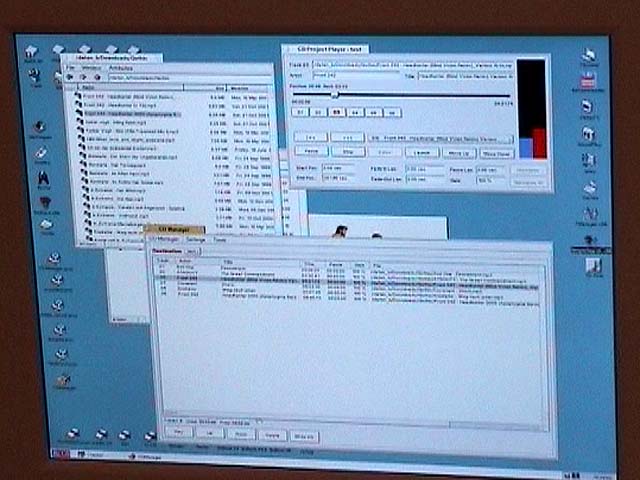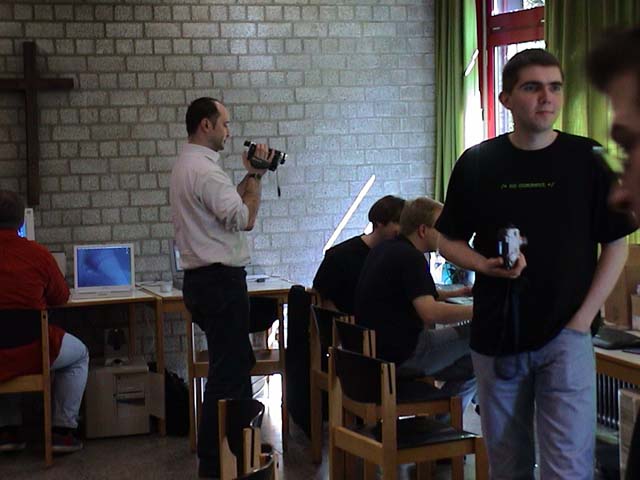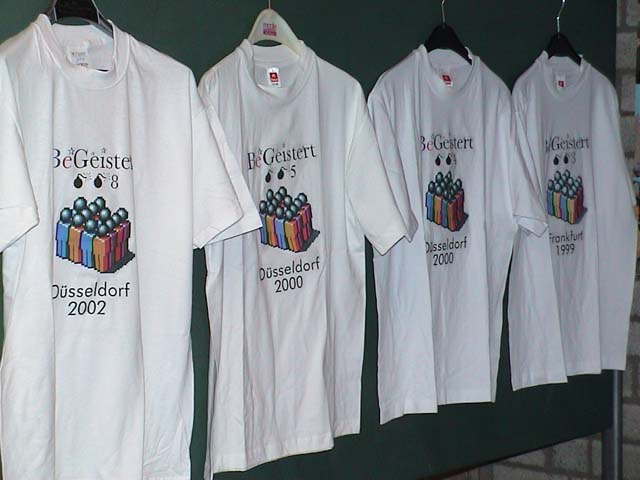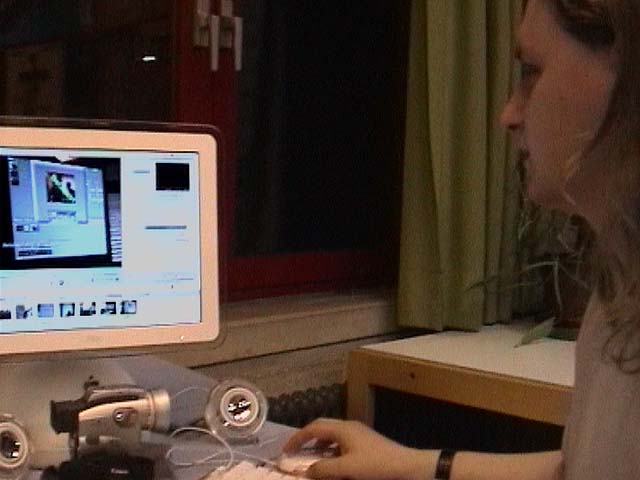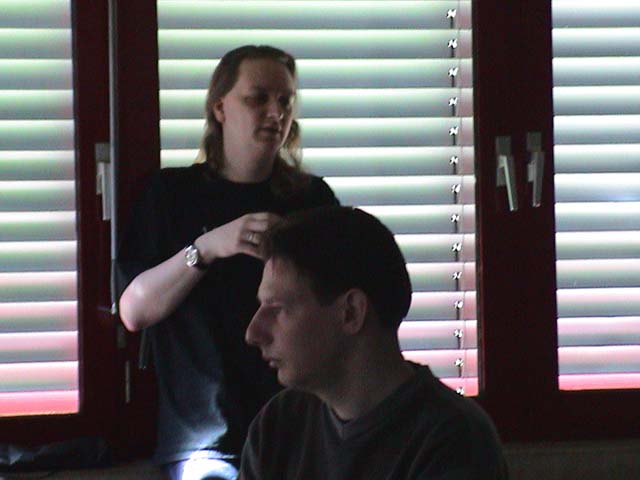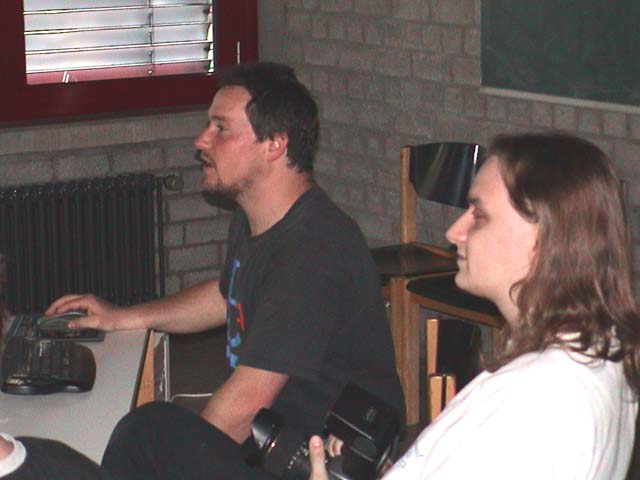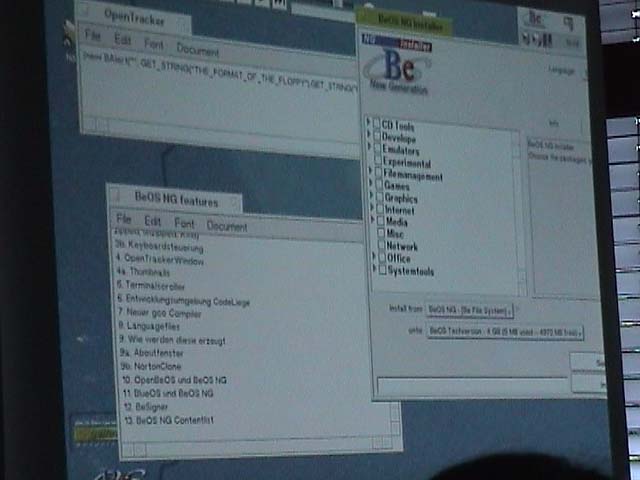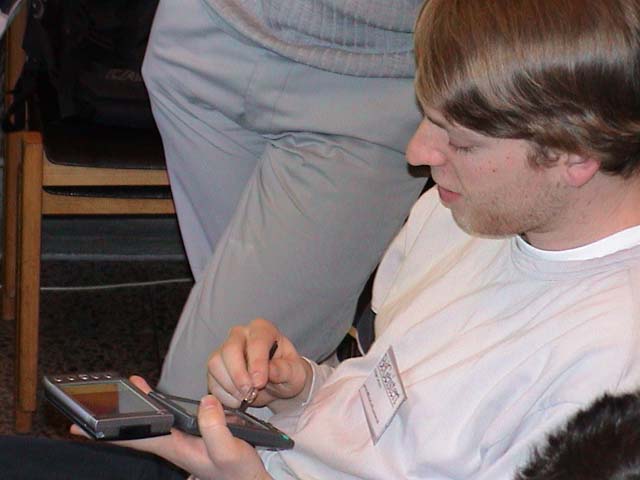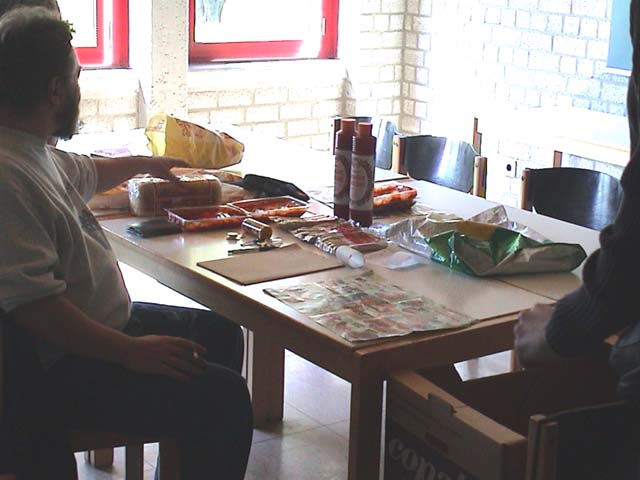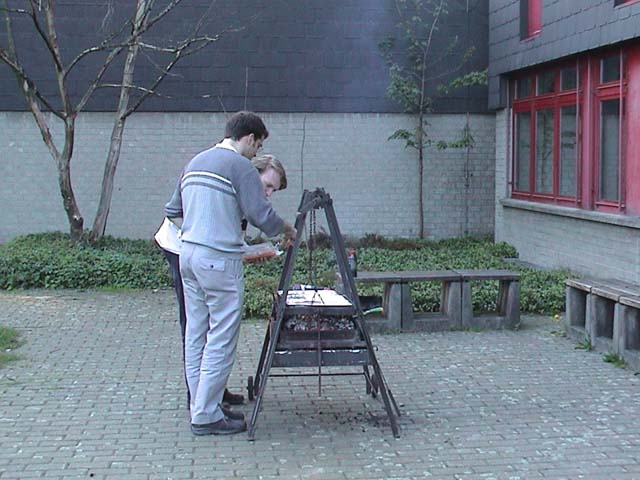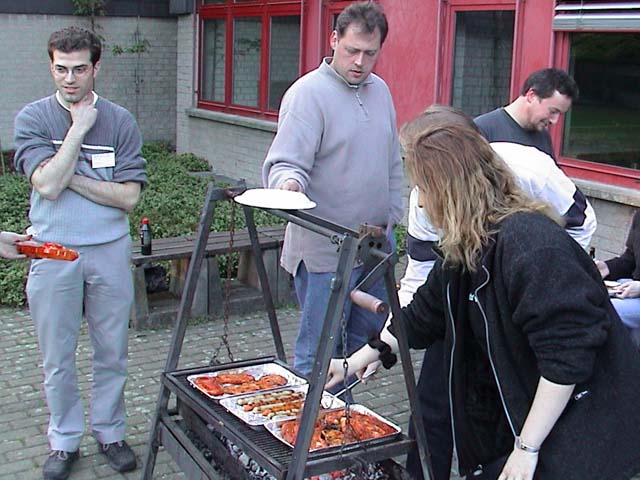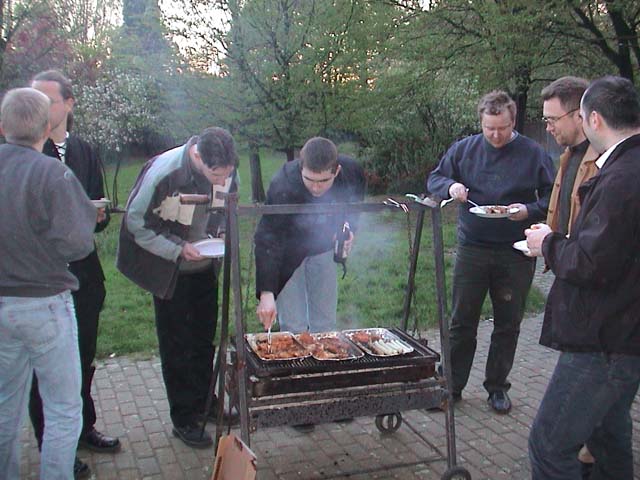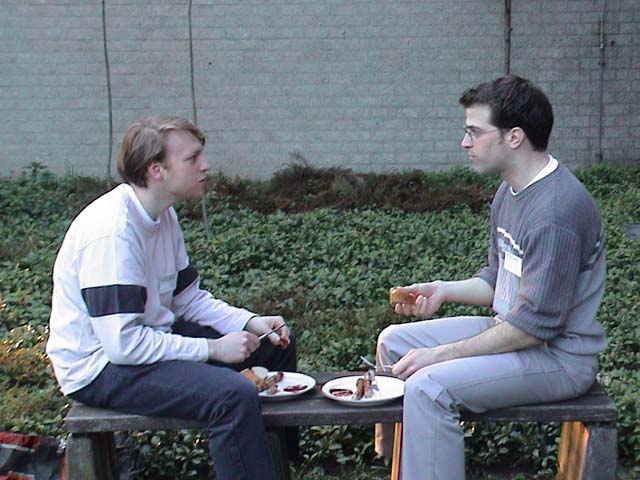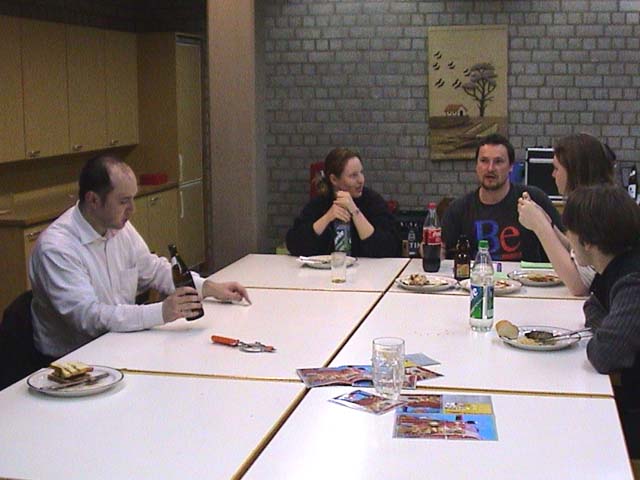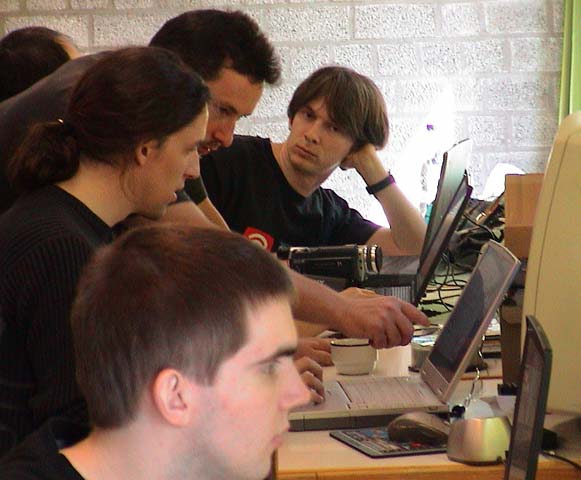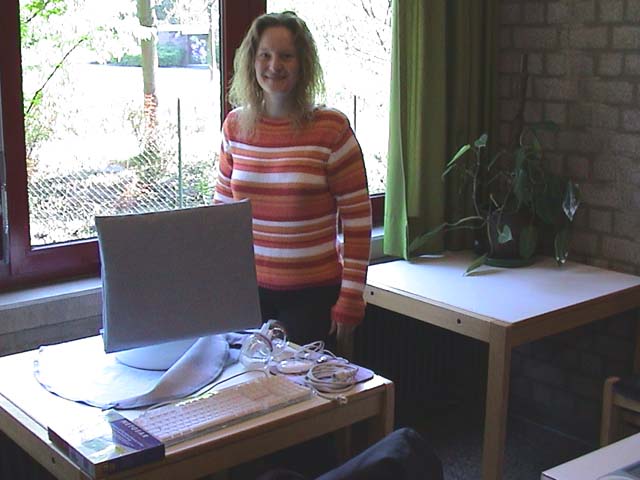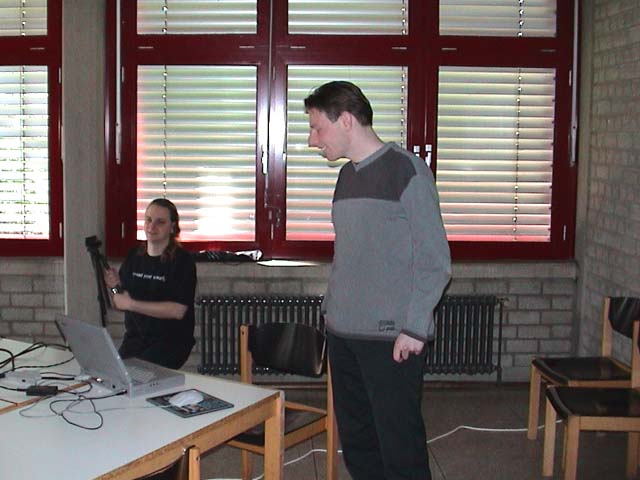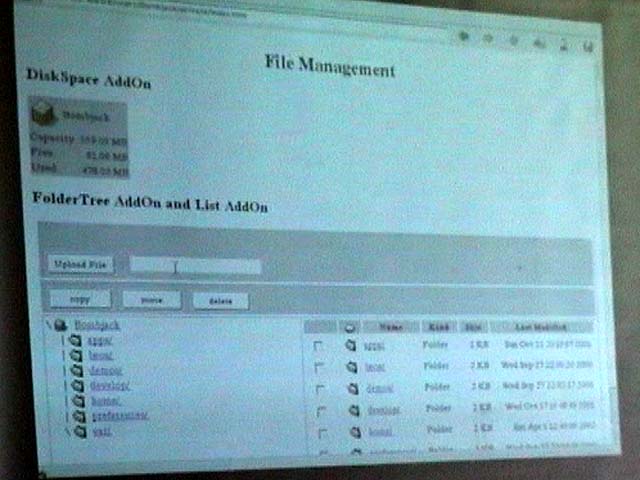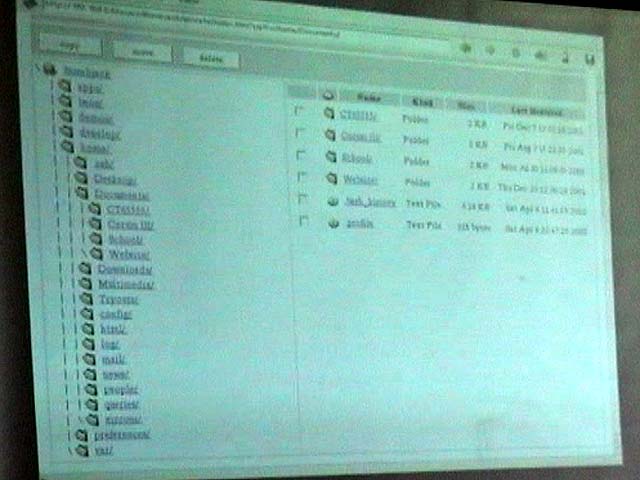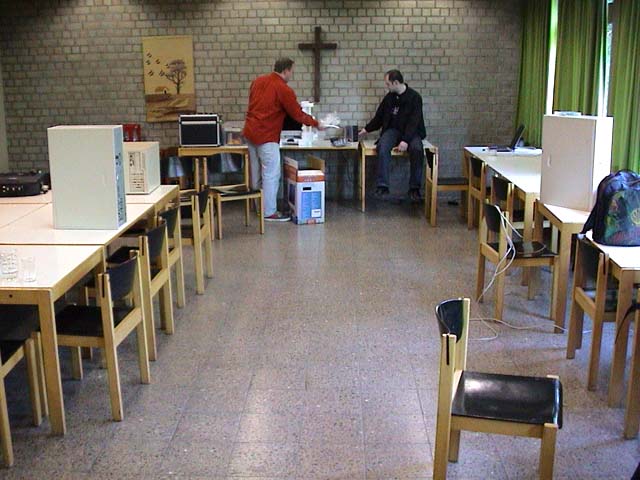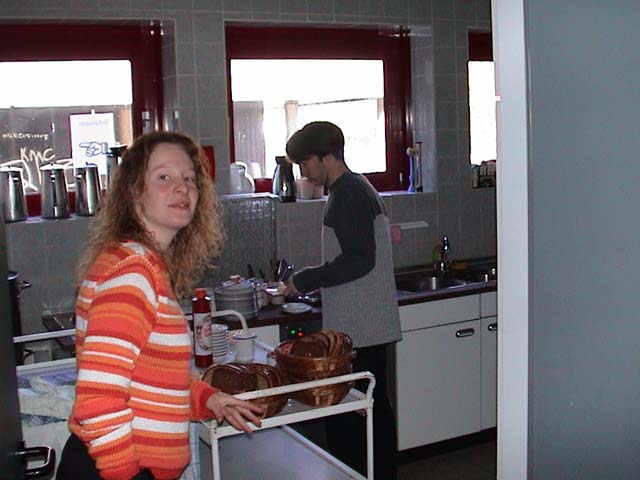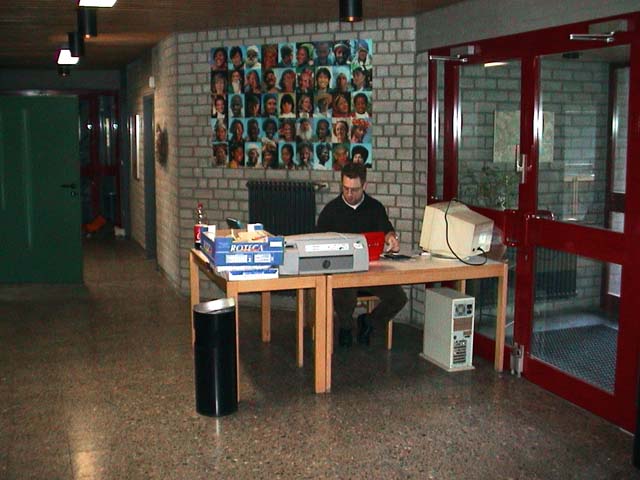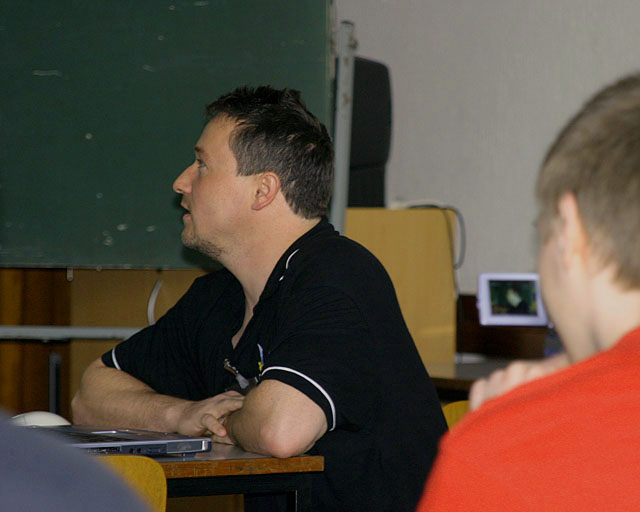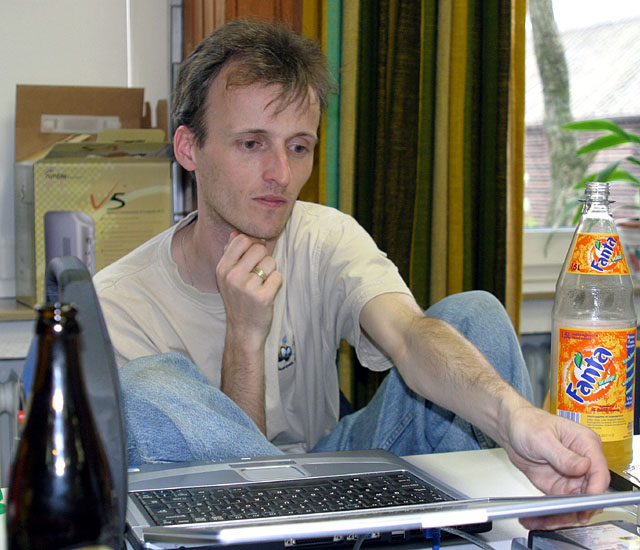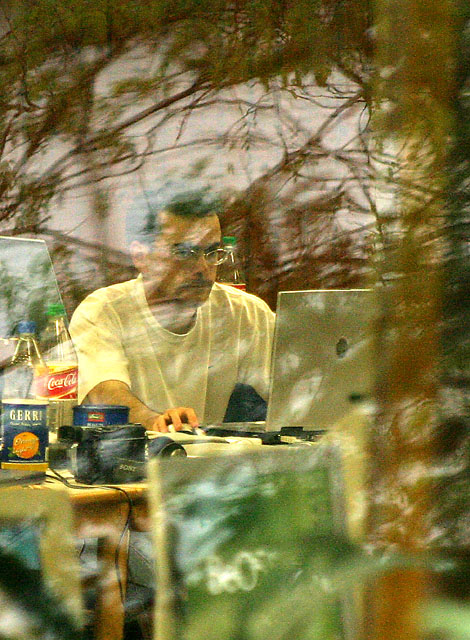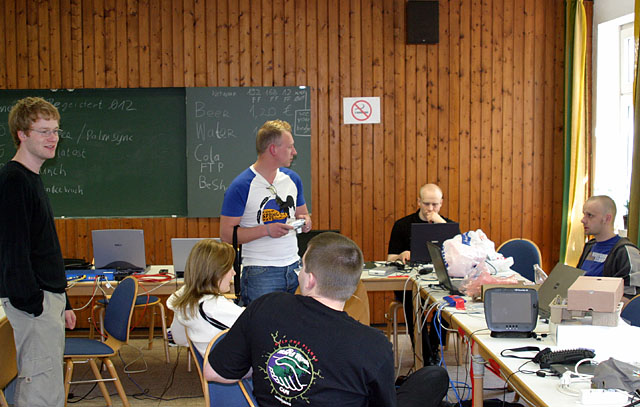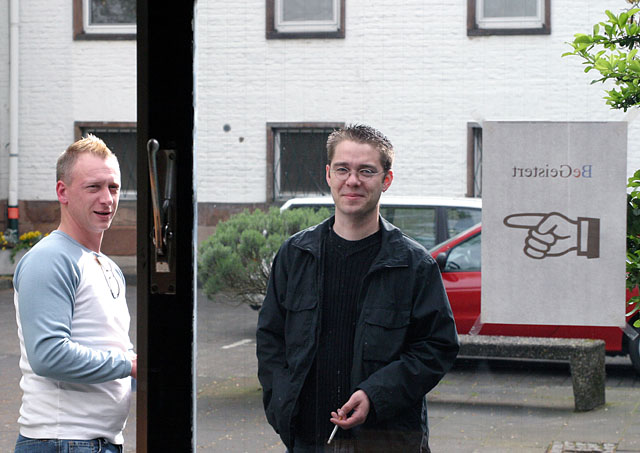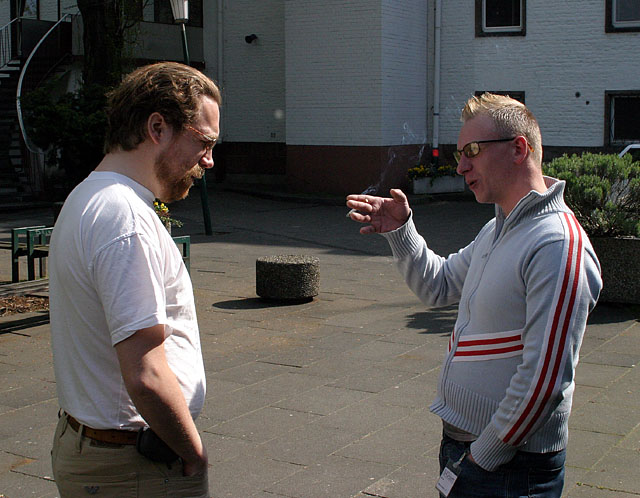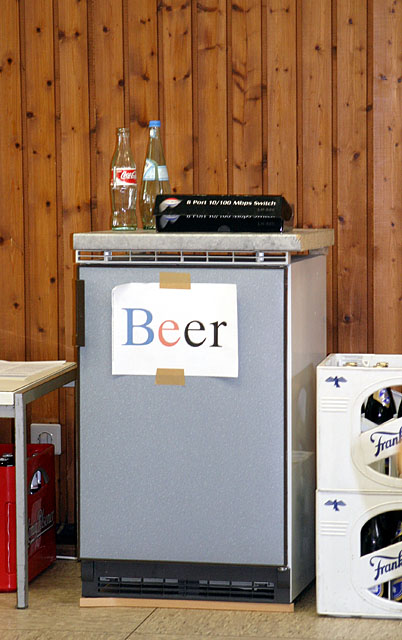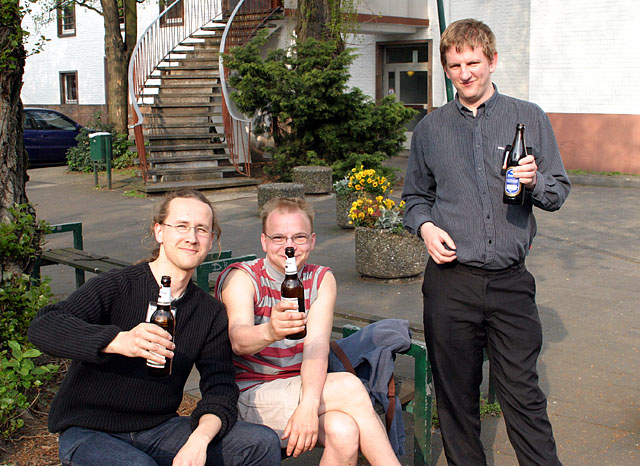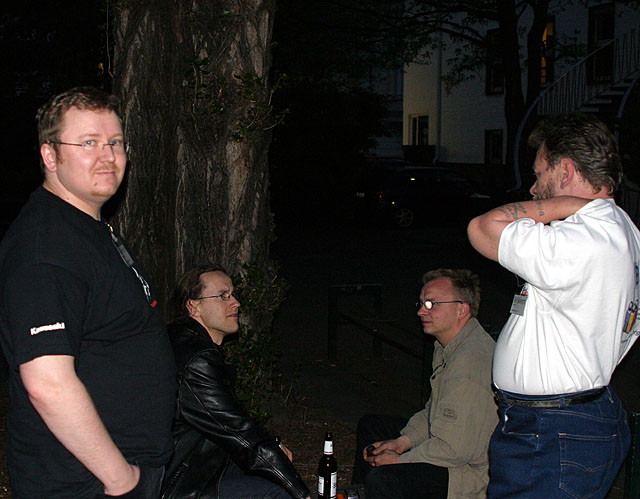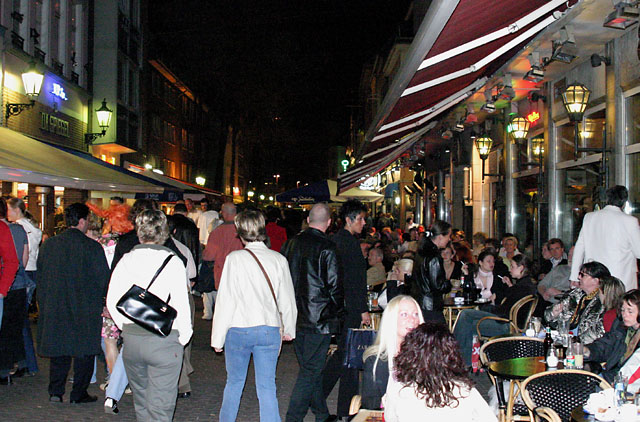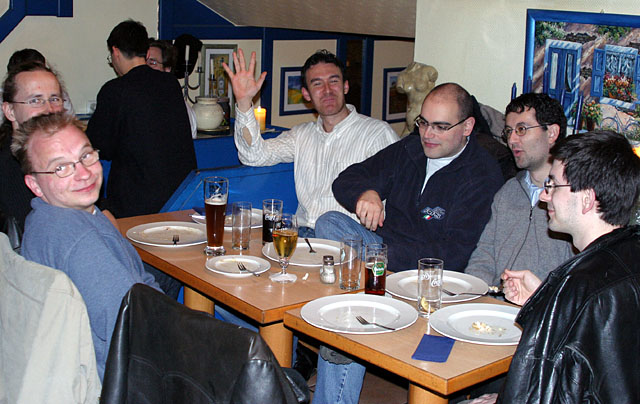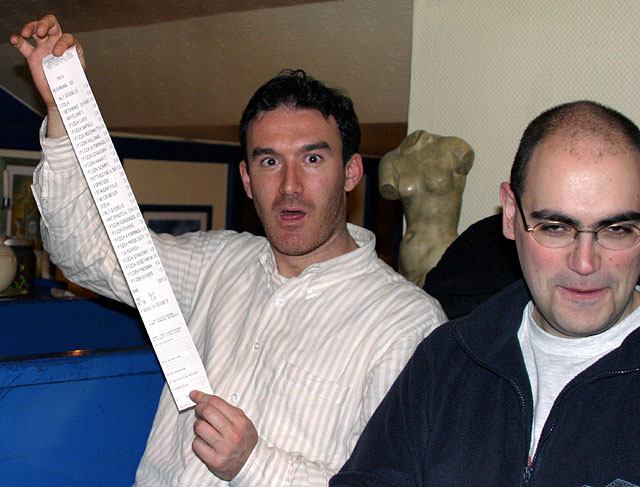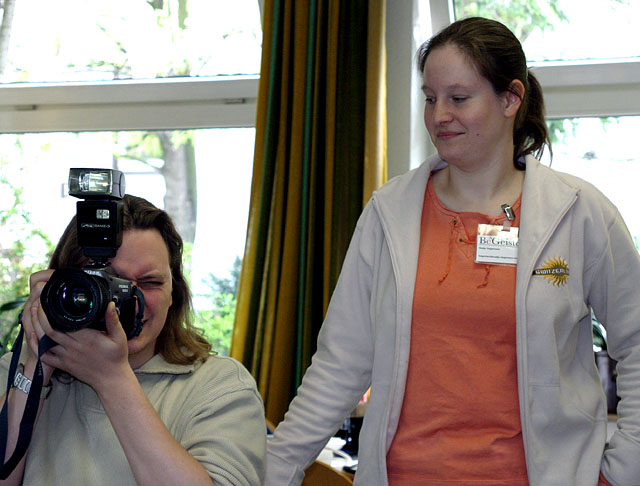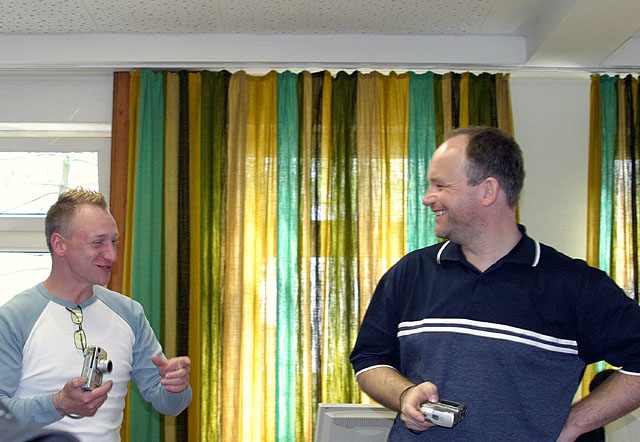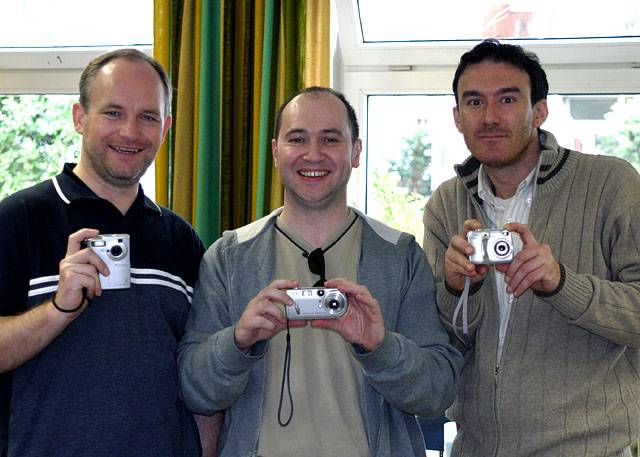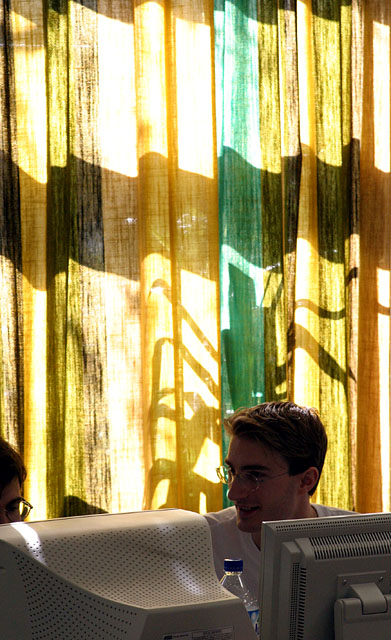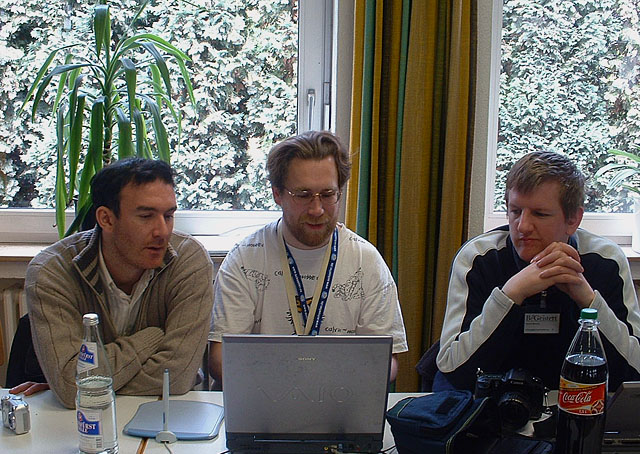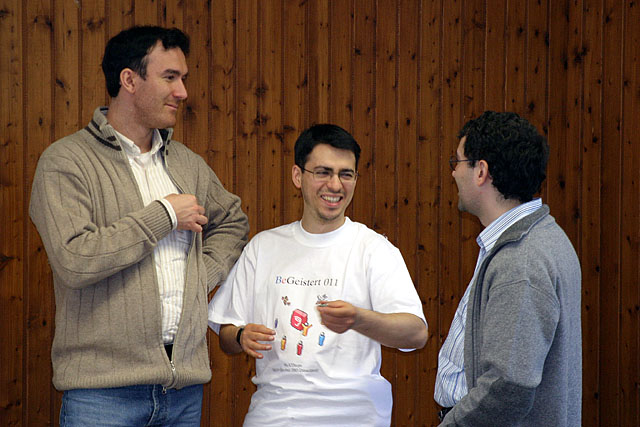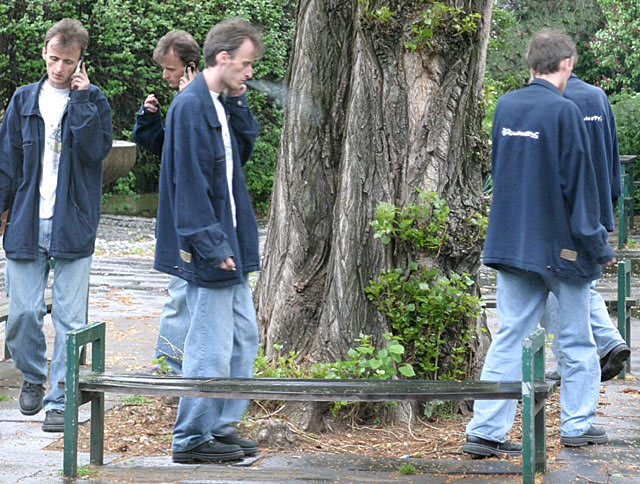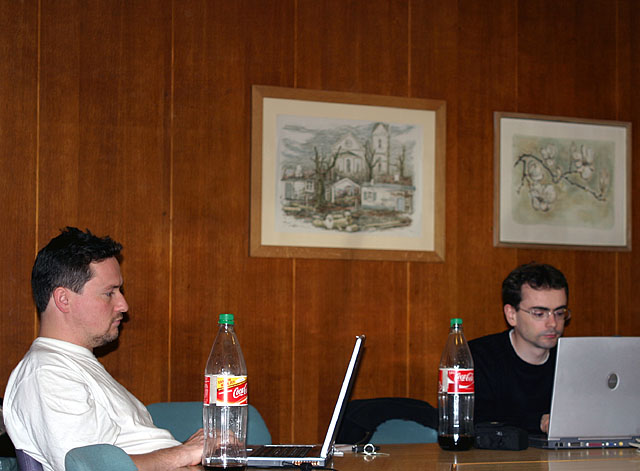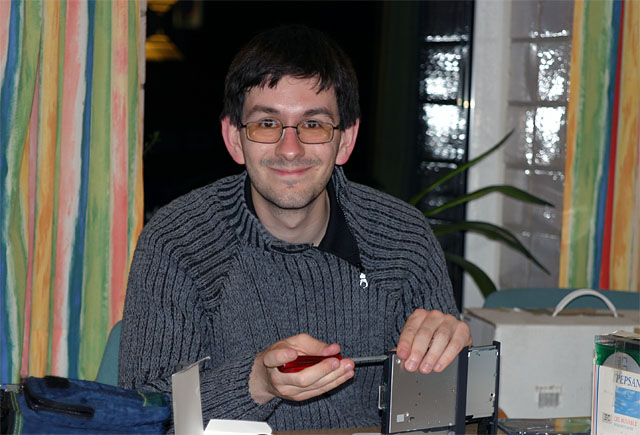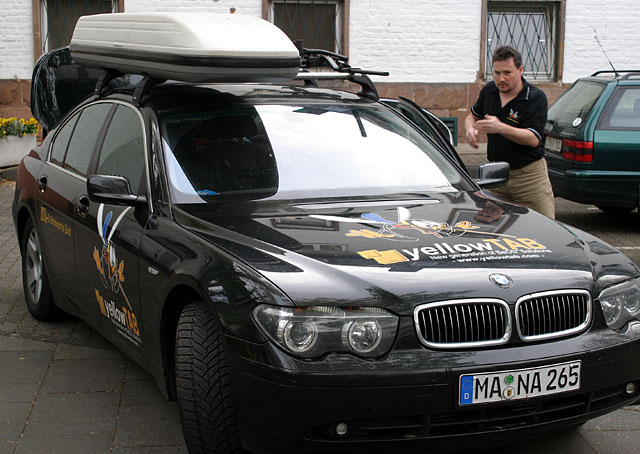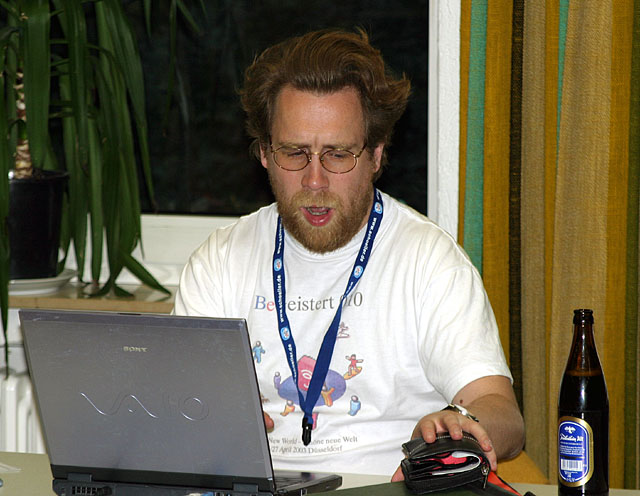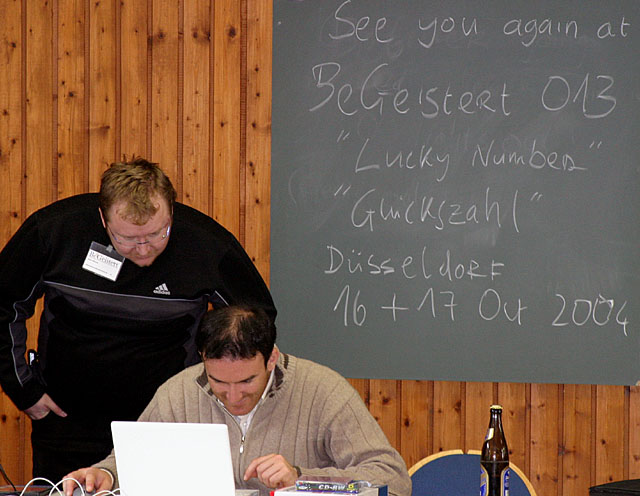- Details
- Written by: admin
- Category: Begeistert
- Hits: 4221
BeGeistert 008 - The Road Ahead - April 5 to 7, 2002 Düsseldorf
Article by Nicholas Blachford April 2002 - blachford.info
* Special thanks to Nicholas, to allow us to add this report into our knowledge base.
BeGeistert is a biannual meeting of BeOS users and developers held in Germany. It's currently held in a church hall in Dusseldorf-Eller.
I've been going since Number 4 and I thought I'd write my impressions of it and my thoughts of the things discussed.
I travel from Amsterdam in the Netherlands via the high speed train which takes 2 1/2 hours. While this may sound long it's a short journey compared with the 5+ hour drives some have to do - Germany is a big country. Germany is also using the new Euro currency so for the first time I went to a different country without having to change my money and this consequently saved a lot of hassle.
While the main event is Saturday and Sunday if you are staying on site (there are plenty of rooms to sleep in) you can stay Friday as well. I did my usual routine and turned up when most people had already gone out for something to eat. However there were a few people to chat to and good German beer on hand - the local brew "Alt" takes some getting used to but you can drink copious amounts without getting even a hint of a hangover..
Later everyone else turned up and Bernd showed a movie of what appeared to be a visit to Be.inc filmed before Be was claimed by the great geek in the sky. I should at this point point out that unlike pretty much everyone there I don't speak any German (duh - it is in Germany). This isn't much of a problem as everyone there can speak English but I do miss out on some things. I'm well used to this as I live in Holland and don't speak Dutch...
BeGeistert has become almost a social gathering as you recognised the same faces each time and as ever I had conversations with various people. On the first night I ended up discussing the merits of free (as in beer) software until 4:30am - the point being that open source is not only non-innovative but may also work against innovation as anything new is immediately copied and thus it's difficult to run a business based on it - an interesting point.
The next day I got up late as usual but still managed to get something nearly resembling breakfast. There were more people as would be expected and as usual some were engaged in conversations, others were coding while yet others were engaged in conversations about coding.
There were the usual smattering of computers sitting around along with the obligatory network. Interestingly, by far most this time most were laptops, and all but one of the rest had LCD monitors. I guess everyones got fed up lugging heavy PCs around! There was even a new iMac present (the weird looking one) and Peter kindly gave me a lesson in video editing OS X style (the iMac belongs to his wife Nadja who was also there), just plug in the camera, grab the footage and start editing, very easy. I want a Mac.
One conversation that came up was the cost of Macs, they are generally considered overly expensive but is this really true? Firstly they are compared to bargain basement PCs when they should really be compared to Compaqs (or the like) where the price difference is smaller. Additionally nobody adds in the cost of the included software (iMovie, iDVD etc) or free developer tools, add the cost of purchasing tools of this grade for the PC and I don't think there would be much - if any - price advantage left.
The event consisted mainly of people sitting around chatting and using their PCs. There were a few DVDs being played, cokes being drunk and even some coding - Marcus Overhagen was working on the OpenBeOS Media Kit. Many pictures and videos were taken, You'd wonder if it was a Sony user group with the number of cameras and Sony laptops around. There was even a "Future BeOS" meeting - several people had PalmsOS PDAs... Palms always appear at BeOS events and IIRC ex-Be Fearless leader JLG was in charge of the Apple Newton project and may have been involved with Palm at one point.
For lunch we got the usua l- what else but pizza??? Then Bernd gave us a presentation on BeOS NG. There was very recently an announcement by YellowTab (the company that Bernd runs) that they had lost their financial backing and had to abandon the project. However, there was so much work put into BeOS NG that it's going to be finished off and sold for 49 Euros a pop. Bernd is also in discussion with the OpenBeOS and Blue OS guys.
While the presentation was in German there was also a visual display on the beamer and we could see the installer and all what it can install. This is a very big collection as it not only includes BeOS personal edition but appears to also include pretty much all of Bebits! All neatly packaged in the installer at 49 Euros it'll be well worth it even without an OS. If you ever get bored there are dozens of emulators so you can play with other systems as well.
That evening we had dinner in the shape of a "BeBeQue". Plenty of Sausages and stakes were cooked up on a "holy" BBQ (it belongs to a church and had a big hole in the bottom). It took quite a while to cook for everyone because of the sheer amount of food but it made a nice change from the usual where we go into town and have a meal (usually sitting outside and freezing!).
That night some people went off to watch a movie on the beamer (it was better than everyone being crammed around a PC) while Peter grabbed the video I had of a previous BeGeistert (005 uncut!) and made it into a quicktime then DVD movie. This took a while as the tape is an hour long and after recording it we discovered the recording mode of my camera was incompatible with his camera. It proved popular as a few people wanted copies.
Then someone put on a German cartoon and a crowd of us watched it, I've haven't the slightest idea what it was about but it was very funny.
On Sunday I got up at something resembling a sensible time which is very unusual for me and I got a proper breakfast, The supplied German breakfast consists of bread, butter, slices of meat, cheese and coffee. For a British person this is highly weird but I'm guess used to it now.
Mark Hellegers gave a demo of his FileDisk program which allows web based control of files on a BeOS system. You could do this with other systems but this allows you to access all of the attributes which BFS gives you. He couldn't really demo it properly as his presentation was given from a 32MB laptop which wont run Mozilla. It doesn't work properly with Net+ (not much does these days) but we could see the general idea as it could produce the displays.
Previous BeGeisterts, especially a couple of years back were much bigger with many presentations going on and with new software applications being shown off. Since then the numbers have dropped off, having said that I don't think this one was much worse than 006 or 007 (license to code). One major difference was that there was none of the prevailing doom and gloom of before, There is no uncertainty any more as BeOS is now officially dead and the future is what we make of it.
The talk was instead of OpenBeOS (OBOS) and what they are planning. There is apparently a 2 stage process where the first is to create a BeOS replacement. Some nasty bugs have apparently been found in the BeOS and these are not being duplicated! They have also put in things like mmap which BeOS never had but many unix programs (i.e. MySQL) need. That said given the resources Be had they did an excellent job, so some bugs were only to be expected. MS with 100 times more engineers and massive profits have yet to produce and OS even close to BeOS. Er, rant over...
The second stage, OBSO is the so called "glass elevator", this is the next generation and there are ideas a plenty for it. One thing being worked on is media output over the web. This raises the question of what OBOS is going to be optimised for, general servers need to handle many users with many small files, you can get away with relatively high latency and real time is utterly unimportant. Media on the other had is the exact opposite, relatively few users, with a small number of big files with latency and real time being critical. You cannot optimised for both, it's a bit like the Heisenberg Uncertainty Principle (it applies to more then Physics) in that you can have one or the other. I hope OBOS does not fall to the temptation of building yet another server OS, or worse - the all things for all men approach of Windows and Linux. From what I was told they are going for a specific market so they'll likely do the right thing.
Then it was time to pack up and go home, a crowd of us went for a pizza first, though they thought my choice of spinach, ham with chill sauce was a bit odd. It was good to see everyone again and I hope to be back next time.
As ever Charlie and his team did a great job organising it all and it was much appreciated.
Of course the train was delayed on the way back...
I took plenty of pictures and have included some along with some framegrabs from the video, I've also included a short movie file. I'll apologize in advance for my sarcastic comments :-)
Pictures

Oh no not again! - Me in action.
(Thanks to Marcus Overhagen for the pic)
Made available by BeSly, the Haiku, BeOS and Zeta knowledge base.
- Details
- Written by: admin
- Category: Begeistert
- Hits: 4254
BeGeistert 005 - Arena - 7. to 8. October 2000 Düsseldorf
Article by Oliver Thylmann (BeNews) - Article from the InsideBeOS magazin
* Special thanks to Oliver Thylmann and Bernd Korz, to allow us to add this report into our knowledge base.
Once again, BeGeistert was blast, especially with the availability of a multiprocessing dual coffee machine which made the nights longer and the mornings more worthy of a smile.
BeGeistert has never been an event for sleeping and with more people there than ever, this situation did not improve. Now for what happened (cool stuff) and who was there (cool people). What am I talking about? Read on...
Before i start with anything else I would like to thank the BeGeistert Team for their great efforts and to congratulate them on a successful event. This one goes out toCharlie Clark, Markus Maier and Eric Tiggermann who organised BeGeistert this time. Marcus Jacob took care of the Coding Event and I was there standing on the sidelines mainly as the connection to BeNews.com to keep people informed.
First off, the participants. It is a very interesting list. My biggest surprise was ported the amazing Groovemaker at BeGeistert again. He actually got out of BeOS some time ago tp persue other interests and told me he did not plan attend. Then he registered under a false name because he knew I wes getting all of the sign-ups. To cut a lonmg stroy short, it worked out just fine. I was totally taken aback by his presence, having come to meet old friends. This does not mean he is back into the BeOS yet, but he is a great guy to have at the event (and yes, he was part of the coding event). Actually, after having won the Best Port from another Platform category in our BeNews Guru Awards, he told me that he would be getting back to Groovemaker on BeOS, fixing all of the bugs and seeing if he can implement saving direct-to-MP3.
Same as last year, Ernst came over from Holland to make it two BeNews guys at BeGeister, including myself. But this year Jamie, who is currently living in Belgium for a year came over, too, which made it three and it was a really nice thing. It is interesting to meet one of the people you are doing great things with for over two years in real life for the first time. Jamie proved once again that everybody at BeNews is a great human being and a wonderful person to have fun with.
Then we have the BeBits.com guys. Yeath, they were there. They are currently in London/UK and didn't want to miss the biggest independent BeOS users meeting wolrdwide. I picked them up personally in Aachen, where I live, and we went to Düsseldorf together. They are really nice people and I have to say it was fun having them around and meeting the two people behind the biggest BeOS site on the net.
Bernd Thorsten Korz, who is doing the InsideBeOS magazine was present and had some very nice information for us which we will tell you about in detail once we have it and when we can disclose it in full.
One thing we can already say is that InsideBeOS will be available within a week for the fist time in German, English, French and Spanish. They are currently still looking into how to really get it to the US.
Dirk Olbertz, working behind Ornament Tool and other things at the moment was also there and as insightful and as informative as ever. He is doing some great stuff for BeOS and you should remember his name for the future. He is showed me one of the most amazing bugs in the media kit, with his mp3s playing 13% faster than normal speed. Now that is a cool bug.
Stephan Assmus was there, the winner of the Best Neophyte Coder award in the BeNews Guru Awards. He was doing a lot of things in the coding event and gave a very well-received demo of his applications, showing how you really do things. All his apps are written out of a need for doing specific things and those things have been implemented perfectly into those applications. Just take a look at the beauty of ColdCut and we will keep you updated on eXposer once we have a full review. Not to forget here is Ingo Weinhold who did some of the cheesy parts of ColdCut and eXposer, like the algorithm behind the presentation of audio in both of the applications.
Erwin Coumans from Not a Number, the people behind Blender, was there to demo GameBlender, but really spent most of his time at the Coding Event. I have to say that I am not a person who can judge how good he is at what he does, but from everybody I have talked I have the feeling that I should be amazed. Everybody was shaking their heads in amazement saying that he is really knowledgable at what he does and wants things perfect. I must admit I realized this during his GameBlender demo, when he was talking about collision detection, implementing life-like body movement routines and other things. Look out for those people.
Peter Stegemann was somebody I had last seen at CeBIT 1998 where he was demoing the different server application (e.g. Diner) from Stegemann Inc. It is very nice to know this guy is still araound and I am lookig forward to seeing the servers run on BONE.
Marcus Jacob from BeEurope (though not on official business from there) and AiXplosive attended BeGeistert to have a lot of fun too. He even met some old friends in the city on Sturday evening and was mostly found at the Coding Event getting things done and organized.
Sander Stoks from Adamation came over both days and demonstrated personalStudio on Sunday, a demo I sadly missed. But I saw him listening to the other demonstrations with great attention and we might see some of his work in Inferno, a demonstration that caught his attention as he is still developing Becasso. I also learned that he is part of the OpenTracker team and that they might include some of the features from OpenTracker. NewFS in future releases.
Wonderful news.
Mark Erben from Cologne in Germany got close to standing ovations fr his BeOS advertisment/demo/party video. It is very good stuff and we will see if we can get it to you someshow in the near future. There are some legal issues to be settled on this one but, wow! I will stop here to not get you all too excited.
I see a lot more faces in my mind, like the two people who filmed many of us for a university paper on Interface Design in Operating Systems and boy did they ask good questions.
Then there were all of the coders from the conding event, who took up the task of building a game library with a running game within a weekend.
On to how the event "worked". Most of the attending BeOS lovers slept at the event or stayed awake very long until they went to teir beds one floor above before getting up again just a few hours later. There was too much to talk about at BeGeistert 005 go to bed, really.
You could sleep when you arrived at home, which many probably did, but this turned out to make the organisation of the day a little harder. Some of the people sheduled to do presentations where just not awake or if they were awake, not in a state of mind for a good demonstration. This all meant the paper with the demonstration and workshop shedule ended up being rewritten several times a day.
This does not mean there were no demos orbad demos though. Far from it. There were great demos about eXposer, ColdCut, Inferno, personalStudio, A BeOS Video (no more to say about this time), Siegfried Backup, Squirrel, ... My own BeOS demonstration, which turned out to be more of a chit chat about the OS with interested people, took close to two hours and was a lot of fun.
A lot of the attending people were also locked away in the 48 hours coding event. This was partly due to the nature of the project that was chosen this time. A gaming library including a game. Wow, that was and is all I can say about this.
There were people doing a song, sounds, pictures, caracters, the library, add-something-I-have-forgotten, add-another-thing-that-the-non-coder-that-I-am-tends-to-forget, ... You get the idea. I think that this is really a big project but having somebody from Not a Number there to give his ideas helped the project to achieve some big things and I will be looking forward to seeing the result, which should appear in the coming weeks.
And I will not take no for an answer in terms of a release of the game, as I have endured the search for suitable sounds for the game until early in the morning which was a pain for the soul.
 |
Update: I was reminded that there was a giveaway at the end with two Gobe boxes and even a Pixel32 license among others. Very nice stuff. |
There might be a lot more I could say about BeGeistert 005 but it is really something you have to witness to realise how wonderful it is. We will keep you updated on the next event and if you have any questions, just ask and I will try to answer in the Forum. See you at BeGeisters 006.
Made available by BeSly, the Haiku, BeOS and Zeta knowledge base.
- Details
- Written by: admin
- Category: Begeistert
- Hits: 4673
BeGeistert 012 - Dirty Dozen - April 17 to 18, 2004 Düsseldorf
Article by Nicholas Blachford April 2004 - blachford.info
* Special thanks to Nicholas, to allow us to add this report into our knowledge base.
This years first festival of BeOSing was held again at the Dusseldorf Youth Hostel April 17-18th April 2004. As ever it started on the Friday night and these days you can also stay the Sunday night, I missed number 11 (which I am told was the biggest ever) but I made it this time for my 8th BeGeistert.
The timing was especially apt because I had to recently give up my iBook (wasn't actually mine) so I'd just gone back to my PC running BeOS (The dodgy Dano and a perfectly legal BONE 7a).
I nearly didn't go this time after I checked the cost of the train fare but luckily myself and Francois Revol managed to get a lift from Jerome Duval who was driving. Francois came complete with a full PC in a handy (not) carry case. These days almost everyone uses lap tops, in the earlier BeGeisterts I went to (4 years ago!) it was mostly desktop PCs.
As per usual I arrived late after everyone had already gone for food but we managed to bump into most of them on their way back while we went. I think it was the first time I've been in a German restaurant without someone who speaks German so that proved to be an interesting experience.
After that it was back to the hostel to catch up with everyone and drink plenty of Alt while doing so. Alt is an interesting beer and a pretty amazing "digestive aid" but I'll not go into details of that aspect...
As usual everyone sits around to all sorts of strange hours on Friday night catching up on the news and general goings on. I haven't really been following the goings on in the BeOS world for some time now so there was a lot to catch up on - and boy did I catch up!
The BeOS world has had some problems of late and I heard various bits about this, it seems there is a lot of misinformation and rumours going around so, given what I've learned, before I go into the main review I'll comment on this.
BeOS Max
Some seem to think this enhanced version of BeOS PE (Personal Edition) is illegal which is a highly questionable view. At most it may be in breech of the PE license but since that license is with Be inc - a non-existent company - it's difficult to do anything about it. PalmSource may be able to do something but since it's not interfering with their business I doubt PalmSource could justify the cost of doing anything about it. If it was being sold (it's a free download) and thus potential source of revenue they might do something but even then they wouldn't do anything until it made some real money.
In any event all the author needs to do is split the distro in two, installing BeOS PE first then in a separate step installing the changes. I'm not a lawyer but this should clear up any potential license problems.
Zeta
I have been aware of the Zeta project for some time but this time has been something of a revelation. For some time there has been an apparent split forming in the BeOS community with some strongly against Zeta. This seems to be based on rumours such as the following:
- They have no code.
- They have code but it's illegal.
- They have legal code but they're missing a big (important) piece.
- They are going to switch to the OpenBeOS codebase.
- They are only concentrating on eye-candy.
Even my own opinion of Zeta was that it was a BeOS Dano with extras and like many I assumed they would eventually base the system around OpenBeOS. However the rumours have grown to such an extent that some people have turned against it with quite some real zealotry, when bebits recently added outside moderators to remove broken or old links some took it upon themselves to remove some of the Zeta compatible software (Bebits has since suspended the outside moderation program).
I do not understand what people have against YellowTab, they are after all trying to further the platform. Do the detractors seriously think attacking YellowTab is going to do any good? I can only assume the people perpetrating such actions are actively trying to ensure BeOS (and variants) remain dead. It wont have any good effect: When the Amiga community started diverging a lot of (still ongoing) arguments broke out and it drove many users away from that scene.
As I said this time was something of a revelation, Zeta is not what people think. I can say with absolute certainty that zero of the above rumours are true. They have quite simply no basis in reality whatsoever. They are either false assumptions, malicious gossip or both. I think one might have been true at one point but I'm not sure about that and I know it's not true now.
I have no reason to believe anything of Zeta is illegal or that they are missing anything. In fact I have several very good reasons to believe the complete opposite. I can say this because of things I seen, things I heard and conversations I had. The YellowTab people are notably evasive when you ask direct questions but there are always ways and means of finding things out if you really want to.
It may sound like I was doing some form of investigative journalism but I'm neither an investigator or a journalist, I was just trying to find out more for myself and in doing so heard a lot of stuff which all pointed irrevocably to the same conclusion.
YellowTab will most likely neither confirm nor deny my comments here but there is a good reason for this. You can pretty much bet there's an NDA been signed somewhere. Business people understand this but many consumers don't get it, having singed a few NDAs myself I fully understand their predicament they must be in.
I asked about Zeta making use of OpenBeOS code in the future but I was quite surprised that YellowTab don't intend to make much use of it. Much of the community assumes Zeta would switch over to OpenBeOS based code at some point so again this was something of a revelation. This is another case of a rumour being completely wrong, YellowTab are working on what is going to effectively be BeOS R6, with OpenBeOS working on a replacement for R5 using OpenBeOS would be going backwards.
I admit I'm being evasive in reporting exactly what I've heard but this is a dead giveaway. If YellowTab didn't have code or were missing anything of significance they would by necessity have to switch to the OpenBeOS source base, in fact they would probably work on it themselves to speed it's development. However since they are not doing this and have no intention of using significant parts they obviously don't have those problems.
I for one expect Zeta R1.0 will be nothing less than what I would have expected from BeOS R6. I also expect it (or subsequent versions) will be able to handle larger memory sizes - without hacks - and indeed solve the other internal issues present in BeOS.
Perhaps some of those who don't like YellowTab should be looking at the system rather than making up rumours, they're in for a surprise. If they don't like what YellowTab are doing then they can try developing a commercial OS themselves, it's a very difficult and very expensive business. At the same time I also think YellowTab need to work on their PR if they are to get the existing community behind them (they need developers). They are allowing a lot of patently false rumours to circulate but by not addressing them they are at least complicit in the negativity which has developed. That said they are apparently doing quite well in business circles and outside the BeOS community.
Anyway, enough of my rant comment, back to BeGeistert...
Saturday
On Saturday we were awoken by the Youth Hostel blasting us with music at 8:00 AM. They didn't do that last time I was there, and a little annoying after going to bed only 4 hours previously. That said it was useful as it woke me up enough to get up in time for breakfast.
Saturday was a beautiful day with the a good hot sun shining. Of course the sun chooses a day when everyone was inside to shine. There were several presentations throughout the day including Squeezer, Zeta, WonderBrush and generating PDFs in Python.
Squeezer
This is a very clever app for handling archives (Zip etc) written by a Italian guy called Massimiliano Origgi. You may think archiving is about Zipping and unzipping files but Massimiliano has taken it to a whole new level with Squeezer which allows you to arbitrarily add/remove individual or groups of files to/from archives. It also allows filtering so you could if you wished extract only files of a certain type. The example given was that of HTML files, If you only wanted the documentation you could set a filter and only the html files would be extracted. Of course you can also do the reverse so if you had packed a software product and had a last minute documentation update you could add it without re-archiving everything.
Massimiliano also seems to be working on 10 other projects simultaneously (including OpenBeOS) and somehow getting them all done: NewsSniffer reads and displays RSS feeds on your desktop so you don't have to keep checking web pages for the latest news. MultiClip gives you multiple clipboards accessible via the function keys, this lead to quite a discussion on how the contents of each clipboard should be displayed. NetMonitor is a small tool for monitoring your network activity like the one in Windows for monitoring modem traffic. A new FTP client is also in development which will allow you to use the normal window interface to upload and download files. I think he's working on other stuff as well, quite how he manages it all I don't know!
Zeta
Bernd Korz gave us a demo of some of the recent changes in Zeta, There is a lot of work going into Zeta that goes well beyond fancy looking windows. The USB stack is being improved to access a wider range of devices than the current stack which is apparently quite limited, this is proving to be a challenge as the number of devices which actually implement the USB spec properly is quite low.
The preferences system is being completely revamped with preferences displayed in a single window and many new ones being added. There is a lot of work going on under the hood so to speak and the basic applications supplied are also being enhanced or in some cases replaced with better tools - Squeezer being one example.
YellowTab also seem to be answering their critics, the so called "Linux-isation" comments seem to have been listened to and some things are being simplified, i.e. some options have been removed from the installer and even the number of border options have been lowered.
The talk was interrupted by lunch so I missed the second part. There was also a talk on the encryption system being put into Zeta on Sunday but it was in German so I didn't attend.
Wonderbrush
Stephan Assmus showed us the advancements he made in the development of WonderBrush. It was very basic last time I seen it a year ago and has clearly came on a long way since then. It did some pretty smart stuff then but now it's even smarter with tricks like the clone tool being added. This allows you to clone an action so if you drew a red circle it would clone it and you can move it elsewhere. If you then decided you'd prefer it blue you can then of course colour it blue, the power is when you have a selection of clones on screen and you want them all blue - you just colour the parent and all the others will copy the behaviour and also change to blue. This doesn't just apply to primitives, you can also do this with tools, so you can clone a blur effect. What's more since everything is done as layers you can pick up the blur/s and move them around independent of the original image. Stephan has also added a text tool complete with anti-aliasing, it not complete yet but you can do a lot of tricks with it as well.
Stephan also showed us a clever scaling algorithm which he'd implemented in eXposer. It outputs animations and you may wish to scale them when generating a final film. However normal image scaling algorithms tend to blur everything slightly thus reducing the quality. In order to address this Stephan added a scaling algorithm which looks for edges in the image and makes sure they are not blurred across pixel boundaries. The results of this were plain to see with the new algorithm generating much better images.
PDFs in Python
Charlie Clark gave another talk on Python, this time about how he used Python to generate PDFs which were used to produce the badges everyone wears. These were previously done in Gobe but because the main logo was an image they never came out very well due to Gobe's insistence on printing everything at 72dpi (you should print images at 300dpi or better).
This time Charlie generated the badges in PDF using a short script and some PDF generation libraries. PDF is a compiled version of Postscript which is a language for describing pages. Generating Postscript can be a very complex operation due to the number of calculations you have to do but the libraries simplify this process and then creates the PDF.
The end result was a page of code and name badges which look a lot better, though of course nobody noticed this until it was pointed out!
On Saturday night we did a copy of last year's visit to Lupo's Pizza restaurant in the centre of Dusseldorf. The atmosphere was very good and as last year the pizza was made quickly and was absolutely delicious. At the end we all had a small cake to celebrate Eddy's 18th birthday. Afterwards we were treated to a glass of Killepitsch by Eddy and Charlie, quite amusing seeing everyone's reaction after taking a sip - it's potent stuff!
Sunday
Blasted by Music again on Sunday morning though this time I managed 5 hours sleep.
More Python
I didn't attend the talk on encryption in Zeta but myself and Giuseppe Gargaro managed to get an introduction to Python from Charlie.
I've seen bits of Python before and I very much like the concept of a powerful but easy to use language but never really been introduced to it. Many of the concepts are very similar to Perl which I've used quite a bit but the syntax is completely different and much easier to understand. Like Perl, Python is generally considered as a scripting language and can do much of the same stuff in much the same way but can and is used for bigger projects as well. I think one of the biggest differences between Python and Perl is the readability, Perl is a nice language to use but it's very easy to make code completely unreadable, I know one person who once described it as a write-only language! Python on the other hand is designed to be readable by people who don't even know the language and this is very good for readability.
OpenBeOS Media Kit
Marcus Overhagen gave us an update of the Media kit he's been working on. Things have obviously moved along here as we were shown movies being played with different codecs including MPEG 4 and Ogg. Movies can also be played simultaneously.
One thing I was not aware of was the addition of support for 6 channel sound schemes so you'll be able to play DVDs complete with 5.1 surround sound. There's lot of work gone and going into the Media Kit and Marcus is doing excellent work. OpenBeOS is moving along, it's no easy or short progress but they have some very good developers working on it.
Marcus has however had his own share of controversy recently when he decided to charge for a gigabit ethernet driver he's recently developed. Some have asked why it was not free but Marcus's reply is that it took him around 40 hours work to develop the driver and wanted to earn something back for it, he's not exactly going to sell truck loads of licenses so it's not as if he's going to get rich of this.
People seem to be under the impression that drivers are free, this may be the case for open source stuff but the majority of drivers have been developed by paid developers, you pay for this as part of the hardware or OS cost so you don't generally see this. Marcus is perfectly entitled to charge for a driver, if people don't want to pay for his hard work perhaps they should try working for free and see how they like it.
Digital Annoyances
As ever I had annoyed everyone by taking pictures of them but this time I had a better camera so I was a better quality annoyance at 6 times the resolution. Everyone seemed to have a digital camera this time so it'd be pretty hard to avoid having your picture taken.
Of course with film cameras when you run out of film you just reload, no worries about needing to download your pictures or recharge your batteries. My CF card was nearly full on Saturday night but not having a computer with me I had to get the pictures off it. I knew Macs could recognised my camera without any special drivers so Peter and Nadia Stegemann allowed me to use their iBook to download the images. Then I had to find a way of keeping the images but their iBook didn't have a CD-Burner so I transferred the pictures to Marcus' PC, he didn't have a burner either but he did have a FTP server so I could then move the pictures to anywhere else. Eventually I found Francois had a burner so I got the pictures transferred again and finally burned to CD.
Why am I telling you all this? Because on Sunday afternoon I got talking to Jan-Rixt Van Hoye who had written a plug-in for Exposure (an image downloading program) which happens to speak PTP. PTP is a recent protocol for communicating with digital cameras and it turns out my camera speaks it.... aaaarrrrrrrrrrgggggg!!!
Another developer I got speaking to is Oliver Tappe who wrote the Beam (BEware Another Mailer) mail client. Having recently switched back to BeOS I needed a new client as BeMail can no longer log onto my mail server. Beam works fine in this regard and also handles multiple mail accounts which BeMail couldn't. I was wonder why it couldn't send Word attachments and he suggested that BeOS had not correctly identified the .doc and gave it the wrong mime type, when I got home I tried changing the mime type and low and behold it works fine.
Closing
Sunday afternoon most people started to pack up and go home, in the evening those remaining moved to a smaller room and stayed there for a while. Some of us went for a meal at a nearby restaurant which, like Saturdays meal was plentiful and absolutely delicious. Eventually most of the rest left for home leaving only those who were remaining for Sunday night (our car and the YellowTab guys). As usual we sat up most of the night chatting though I was a lot more talkative than usual (I can be after a few drinks), I think one of us remaining had a few too many drinks though - you know who you are :-)
Eventually even us stragglers went home the next day, I slept most of the way back and Jerome managed to deliver me almost to my door. Once I was back I went back to sleep, then I got up had something to eat and went back to bed again, think I tired or something? Thankfully though my dinner didn't try and kill me this time.
All in all BeGeistert was a fun and informative event, as indeed it always is. It is also becoming increasingly international with I think 7 nationalities present this time including groups from Italy and France.
By physically getting people together you find they get on and discuss things much more rationally than on-line where the lack of emotional content means comments are very often taken differently from the way they are intended. Many developers attend BeGeistert, these are the real backbone of the community and are not the people spreading rumours. You have people from YellowTab, OpenBeOS and users and developers of various systems all in one room and it's a very productive and fun environment.
As mentioned I took quite a few pictures at the event, I actually took around 200 but don't worry, I've since selected the best, sorted, cropped and generally tweaked them. I even tried to name people this time (Thanks to Marcus Overhagen for putting names on his site!) - Enjoy!
There are quite a few other sets of pictures and reviews out already and some of these proved rather useful for remembering the details of talks etc - Thanks!
Pictures
Sorry but I'm terrible at remembering names...
 Be panoramic |
 Be panoramic |
Pictures Copyright © N. Blachford 2004
Made available by BeSly, the Haiku, BeOS and Zeta knowledge base.
- Details
- Written by: admin
- Category: Begeistert
- Hits: 4452
BeGeistert 017 Report - "Marco Polo" - December 9 to 10, 2006 Milan (Italy)
Article by DaaT - 18 December 2006 - IsComputerOn
As I'm sure you're all aware, on the weekend of December 9 and 10, BeGeistert 017 was held in Milan, taken outside of Germany for the first time. Community member Giuseppe Gargaro was present and wrote a report for you all to read. You can read the original Italian version here, or click below for his English (with some editing by me) translated version. Enjoy.
For the first time in its history, BeGeistert, the biennial forum for the BeOS/Zeta/Haiku users and developers, was held outside of Germany, particularly in Milan, on the 9th and 10th of December weekend at the Concorde hotel. Normally for me, living in the south of Italy, Milan is only a stage of a long journey towards Germany, but this time it was the point of arrival, so after only seven hours of train here is the fantastic BeGeistert atmosphere.
Normally the event is held at the wonderful Youth hostel of Dusseldorf, while this time thanks to the perfect organization of Christian Celona the event was kept in a grand four stars hotel near the center of Milan. As always, Friday is the day for the arrivals and we noticed at once the absence of the Germans who normally are the main group but job commitments didn't allow all to participate. Also some Italians have only appeared on Sunday, but the participation of the Italian community was good. Also present was Charlie Clark who heads the BeFan group which organizes the event and a pair of French visitors. Previous BeGeisterts, especially a couple of years back were much bigger with many presentations and various new applications, since then the numbers have come down, but it is a period of transition and in spite of the absence of the nourished German group the atmosphere of it has not suffered.
As always one of the interesting aspects of the event is the encounter and the exchange of ideas and knowledge along with the fun moments that normally comprise the evening going out in order to raid some pizza shops or restaurants, therefore Friday evening ended with all in one pizza restaurant in Milan. Friday was a rainy day, but fortunately it left, leading the way for a Saturday and one Sunday of sun.
On saturday I held the presentation of the BePodder 1.2 (media feeds agreggator for BeOS, Haiku and Zeta) application from Funky Idea Software, a tool that brings news, journals, broadcasts and images from all around the world directly to your desktop. There's no more demo version, it has been replaced with a free "Light" version with some limitations.
BePodder Light is the basic version (free download and no time limit) which includes many cool features:
- Easy to use yet powerful Graphical User Interface
- Handles all news/podcast feeds in RSS 0.9, 2.0, Atom, RDF and iTunes (up to 10 feeds in the Light version)
- Fully integrated with BFS (BeOS/Haiku/Zeta file system)
- Integrated podcast, videoblog, image feeds, BitTorrent feeds, newsfeeds and International feeds built-in OPML directories with thousands of feeds
- Advanced channels/lists management with drag and drop support
- Support for more than 10 languages
- Easy to integrate with other applications like BitTorrent/ Installer / Unzip / etc.
- Media players integration with a new Auto option
- BePodder is 100% adware/spyware free
- Zeta (multilanguage) and BeOS R5/Haiku (english only) support
- You don't need an iPod or any kind of MP3 player to use and enjoy BePodder
- The same licence-keyfile can be used to unlock the BeOS R5, Haiku and Zeta versions
The registered version adds some more nice features:
- Unlimited number of channels
- Small Channel view
- Proxy support
- Automatic channels check
- Up to 5 enclosure downloads at the same time. (multi threading)
- Low price, only 15€ (BePodder team will support the Haiku project by donating 20% of the cost for every copy sold)
The BePodder presentation was followed by a workshop on Haiku held by Stefano Ceccherini who collaborates with the Haiku project. Haiku has taken giant steps in the last year and the day is approaching in which we will have R1, Stefano showed the main characteristics of the system and encouraged the community to support and to help the Haiku Team. After five years of intense job it by now seems to handle the name of BeOS Open Source and the possibilities that it offers are clear to all in the community. Also during BeGeistert there was no lack of occasions to discuss the future and ideas in order to diffuse and to support Haiku in this moment when all of us are waiting for its first release.
Saturday was concluded with a fantastic tour in the center of Milan, pulled to polishes for the festivities. During the tour which begun in Brera, we saw the Duomo, the Scala, the Corso and the "haute couture" locations. The tour ended at Pastarito for one abundant pasta plate, and finally we closed the evening in a pub to have a drink.
Sunday I held the second presentation, this time of a new software, Flickr Uploader, which allows the user to upload his/her photos to flickr, the most popular online photo management and sharing community. The software developed by Funky Idea Software is freeware; it is the fruit of the profitable collaboration between four members of the community and is available for BeOS, Zeta and Haiku.
The afternoon was the moment for farewells and for a first balance. The number of the participants oscillated between 13 and 20, mainly Italian plus two French and Charlie who is English. Unfortunately because in Germany it was not a holiday and for personal reasons, less came from the German group which is usually the strongest. Considering this it can be said that the event was a success, seeing the nourished participation of the Italians. The atmosphere was the typical one for BeGeistert, especially in the outings and all were indeed content in participating and many will probably be present in Germany for the next BeGeistert.
We also intensely discussed the reorganization of the Italian community, of the uselessness to divide it. We hope and believe that the results were good and that the community will come out strengthened from the encounter. Our stay at the hotel was quite good and the event room was filled with interesting things: books, one BeIA, etc. Moreover the discussions held were all quite interesting. Also the presence of Stefano Ceccherini was precious seeing his engagement with the Haiku project. He spoke about the future and also about the different visions which exist and believes that to take the project to the end the common factor of commitment to this platform is will strength, and also noticed that despite difficulties the general atmosphere has been one of optimism for what awaits us, encouraged by the news which surfaced during the event, that demonstrated the progress being made.
Thanks to Giuseppe for taking the time to translate his report. You can view pictures of the event here, here and last but not least, here.
- Details
- Written by: admin
- Category: Haiku
- Hits: 4122
Article from DistroWatch Weekly, Issue 650, 29 February 2016 by Jesse Smith
About once a year I like to put aside Linux distributions, and the various flavours of BSD, to look at Haiku. As the Haiku website tells us, "Haiku is an open source operating system that specifically targets personal computing. Inspired by the BeOS, Haiku is fast, simple to use, easy to learn and yet very powerful."
The Haiku operating system is unusual in that all of the pieces of the system are developed by one team. Linux distributions are usually assembled from a collection of thousands of other projects. The BSD projects generally put together the base operating system (the kernel, documentation and command line utilities), but leave creating desktop environments and graphical applications to third-party projects. The Haiku team not only handles kernel and userspace development, they also work on their own desktop environment and many end-user programs.
The project consists of a single team writing everything from the kernel, drivers, userland services, tool kit, and graphics stack to the included desktop applications and preflets. While numerous open source projects are utilized in Haiku, they are integrated seamlessly. This allows Haiku to achieve a level of consistency that provides many conveniences, and is truly enjoyable to use by both end-users and developers alike.The most recent version of Haiku, Alpha 4, was released over three years ago, in November of 2012. The project's website suggests people who want to try more recent copies of Haiku should try the development snapshots. Development snapshots are often a good way to try out new features, but they can be prone to breaking and it's probably not a good idea to install them on any computers where reliability is a priority.
I downloaded the most recent development snapshot, which was available as a 283MB ISO file. Booting from this media brings up a graphical screen. A window pops up and asks us to select our preferred language from a list and, optionally, we can pick our keyboard's layout from another list. At this point the system asks if we would like to run a live desktop environment or launch the project's system installer.
Haiku's desktop consists mostly of open, empty space with a soft blue background. At the top of the screen we find icons for accessing the file system and launching the system installer. A panel in the upper-right corner of the screen gives us access to the Applications & Settings menu. The panel also contains a system tray where we can find network settings and a volume control. At the bottom of the panel we find a list of open windows that facilitates switching between tasks and hiding or restoring windows.
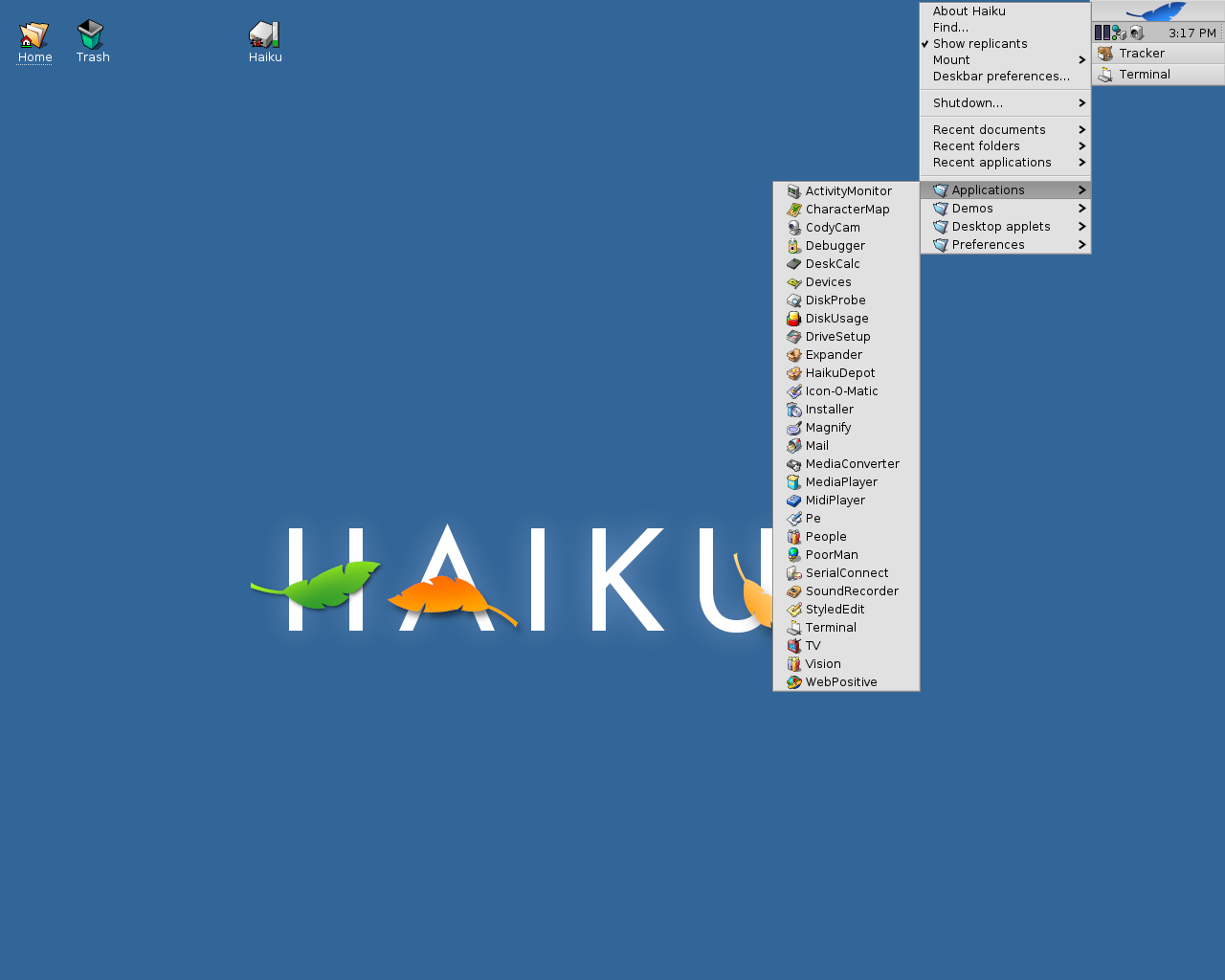
Haiku 2016 -- The application menu
(full image size: 114kB, resolution: 1280x1024 pixels)
Launching Haiku's installer brings up a graphical application window. The installer begins by showing us some important information about the installation process. In particular, we are told we should have a partition set aside for Haiku to use before we begin the installation. While Haiku does feature a partition manager, the developers suggest we might gain better results using another partition manager. The first screen of the installer also includes notes on how to add a Haiku entry to the GRUB boot loader should we have an existing GRUB configuration. The next screen of the installer asks us to select a partition where Haiku may be installed. There is a button on this page that launches a partition manager where we can create and destroy partitions.
The system installer wants us to create at least one partition of the Be File System type. I did this in the partition manager window and then returned to the system installer. At first, the system installer did not seem to recognize the Be partition I had created. After a little experimenting, I discovered the partition must be both set to be of the Be type and then formatted with the Be File System through the partition manager. The system installer does not format the partition automatically and will not allow us to use the partition as an install target until it has been formatted. Once a partition has been properly set up and formatted, the Haiku installer copies its files to our hard drive. This process takes all of about ten seconds. We are then returned to the installer where we can set up a boot loader, if one does not already exist on our computer. If we do have GRUB already installed, we can follow the supplied instructions to add Haiku to our existing boot menu. Then we can reboot the computer to test our new operating system.
The Haiku operating system boots quickly, taking us from the boot menu to a full desktop environment in about five seconds. Haiku is a single user operating system, meaning we have just one user account and there is no password protection in place. This is highly convenient as it means we never need to sign into our account, but it also means anyone can access all of our files simply by booting Haiku.
Haiku is not only quick to boot, but the desktop is also pleasantly responsive. Windows, menus and buttons react almost instantly to input. The operating system, when sitting at the desktop, uses around 180MB of memory and is fairly light on resources when compared next to most Linux distributions running full featured desktops. I tried running Haiku in two test environments, a desktop computer and a VirtualBox virtual machine. Haiku did not boot on the desktop machine, keeping that aspect of my trial quite short. The operating system did run well in VirtualBox. While Haiku was not able to integrate into the VirtualBox environment seamlessly and the default display resolution was low, I was able to increase the operating system's display resolution through one of Haiku's desktop configuration tools.
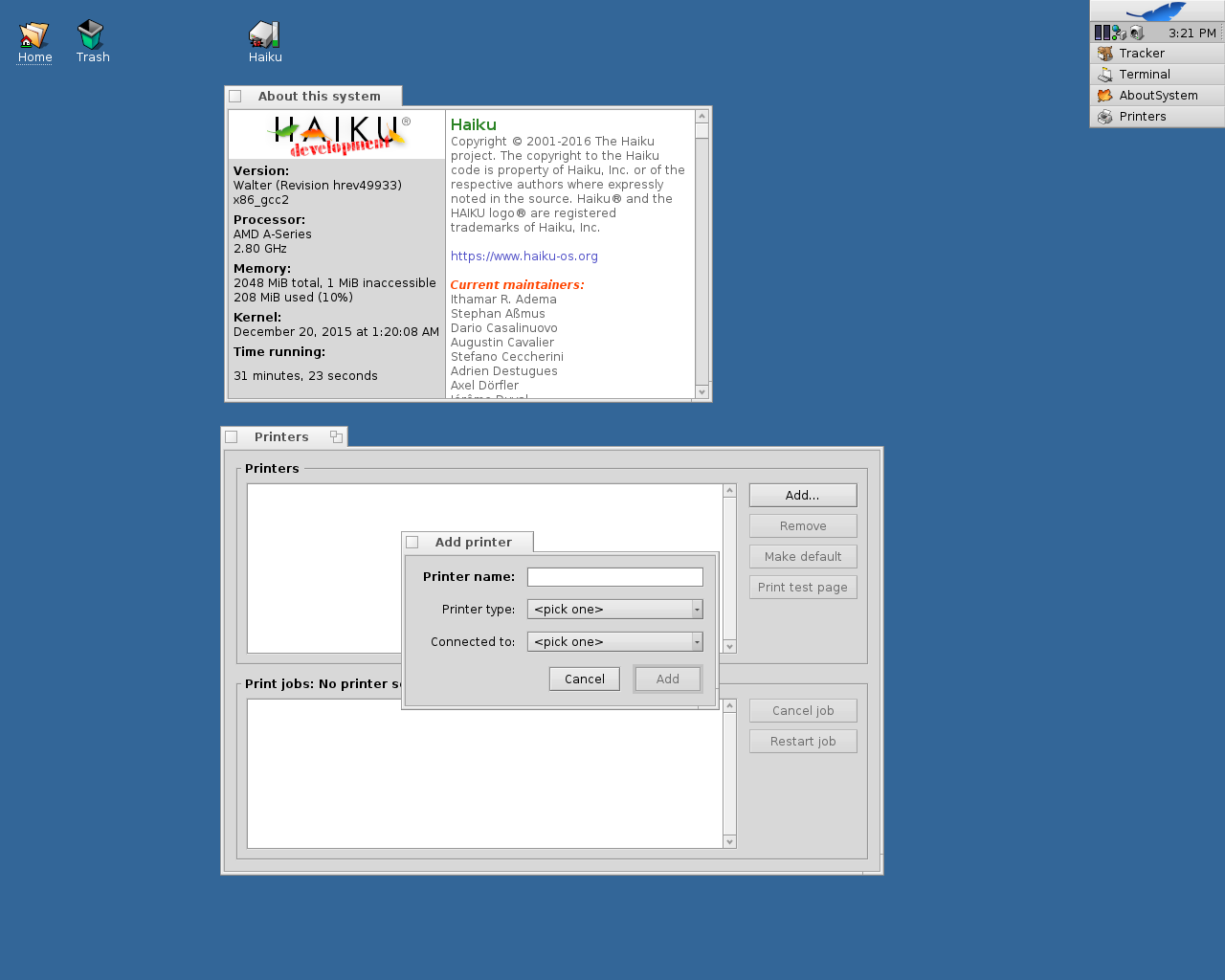
Haiku 2016 -- Trying to add a printer device
(full image size: 93kB, resolution: 1280x1024 pixels)
Haiku ships with a collection of desktop applications which seem to be unique to the operating system. While these programs may be slightly different from those which run on Linux distributions, the functionality tends to be very similar. Haiku ships with a functional web browser, package manager and e-mail client. We are also given a handful of desktop configuration apps, a contact manager and text editor. Haiku ships with a sound recorder, media player, IRC client and even a minimal web server. In the background we find an old copy of the GNU Compiler Collection (version 2.95).
One thing I appreciated about my time with Haiku was that it was usually easy to guess what an application would do, based on its name. For example, it wasn't too hard to guess that "People" would offer address book functionality or that "WebPositive" would be a web browser and "MediaPlayer" would be a, well, media player. There were a few programs whose names were less descriptive. I didn't know before trying them what "Poorman" and "Pe" did. (They were a web server and text editor, respectively.)
Haiku offers us a number of desktop widgets for monitoring such things as the time and system resources. These widgets can be spawned and placed around the desktop. At first I was not sure how to remove a widget after it had been created, resulting in a bit of visual clutter. I eventually found unwanted widgets could be dragged into Haiku's trash folder which was represented by an icon at the top of the desktop.
Haiku ships with a graphical software manager, called HaikuDepot. The depot, as I came to think of it, shows us a window divided into two parts. The top section of the window displays a list of available software packages in alphabetical order. Clicking on a package's entry causes the bottom section of the window to display more detailed information and a screen shot of the application we have highlighted. A search box allows us to try to locate items by name. Near the bottom of the window is an Install/Remove button we can click to cause the highlighted package to be added or removed from our system. The software manager worked well for me and I was impressed with how quickly operations were processed. The only issue I ran into was with my own unfamiliarity with the software available to Haiku users. I could browse for what I wanted or maybe get lucky by searching for keywords that described the functionality I wanted. But being a Haiku novice, I did not always know what was available or how best to find it. For example, I spent about five minutes searching for a screen shot utility, only to finally discover there is not one in the depot because Haiku includes one by default. However, the screen shot program is not listed in the application menu (so far as I could tell) and needs to be invoked from the command line.
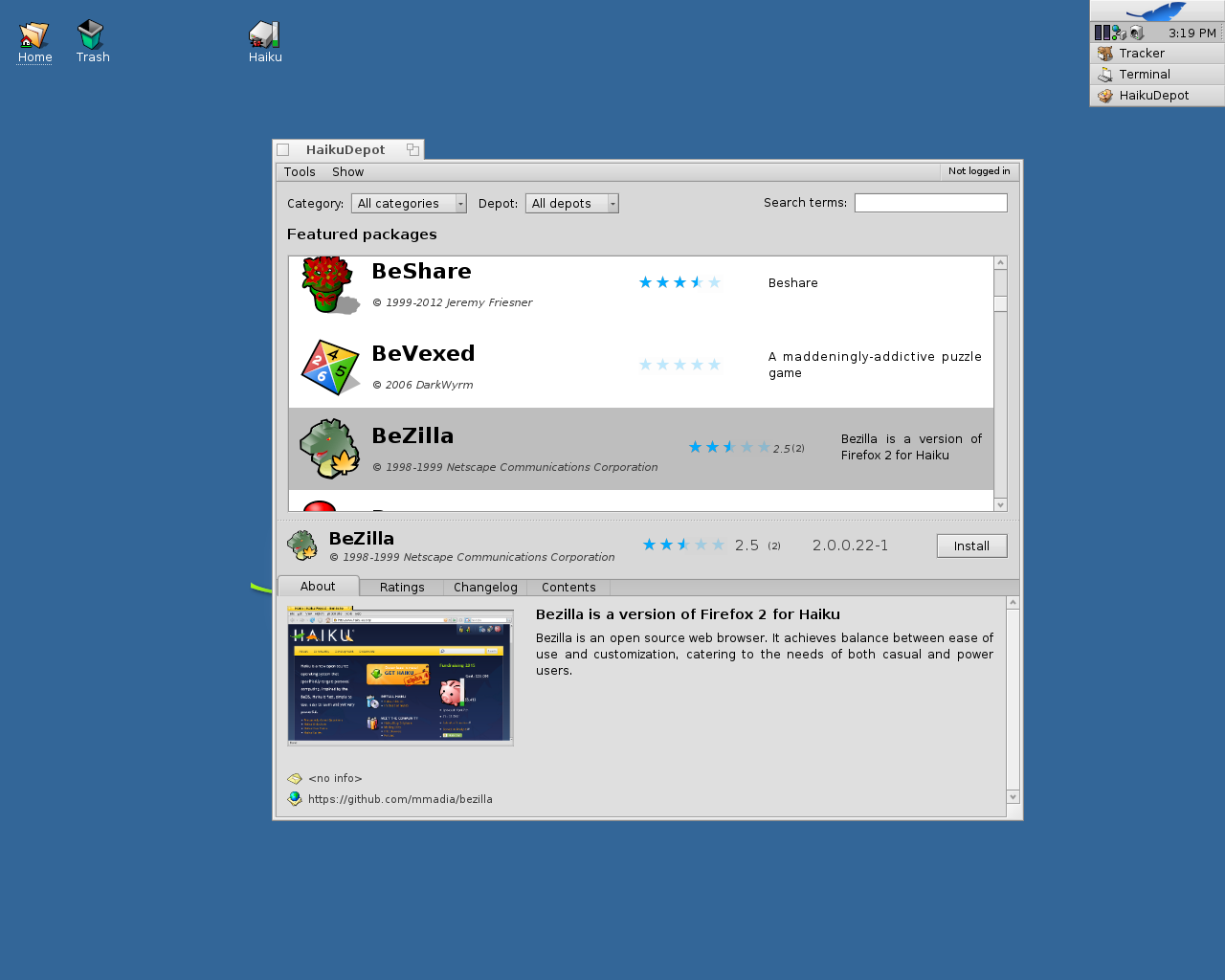
Haiku 2016 -- The HaikuDepot software manager
(full image size: 125kB, resolution: 1280x1024 pixels)
I ran into a few technical problems during my trial. For example, while Haiku's default web browser could display most on-line content, including YouTube videos, watching videos on YouTube sometimes caused the operating system to lock-up, requiring a hard reboot. When I tried playing audio files, Haiku's media player would open the file and then produce sound that resembled rapid-fire Morse Code. This meant that my multimedia experience was a bit limited when running Haiku, but all other aspects of the operating system functioned well.
Conclusions
I am of the opinion the Haiku project is doing a good job of creating an operating system in the modern image of BeOS. It took me a while to get used to the way Haiku does window management and to navigate the unfamiliar waters of the software available, but generally speaking I think Haiku performs well.
Haiku is unusual in that all the pieces of the operating system are developed by one team and I was curious to see if that would make a difference in the style of Haiku or in the way it performed. So far as I could tell, there is not a practical difference from the end user's perspective. Having all the developers on one team may make things work smoothly behind the scenes, but for the person sitting in front of the screen, I did not notice any benefit or drawback to the integrated approach to development.
What did stand out for me was that Haiku feels like a 1990s operating system. Specifically, the lack of user accounts and security checks makes Haiku feel like an artefact of the past. The user can explore anywhere, delete anything, install any software without seeing a prompt for credentials. This makes using Haiku very streamlined, but it takes away our safety net and effectively means Haiku will only be useful in situations where there is just one computer user. In short, Haiku tended to feel like a modern representation of how we used to do things. A well engineered, high performance model of what computing used to be like before most of us got concerned about security and abstraction.
Hardware used in this review
My physical test equipment for this review was a desktop HP Pavilon p6 Series with the following specifications:
- Processor: Dual-core 2.8GHz AMD A4-3420 APU
- Storage: 500GB Hitachi hard drive
- Memory: 6GB of RAM
- Networking: Realtek RTL8111 wired network card
- Display: AMD Radeon HD 6410D video card
Article by Jesse Smith, February 2016 - distrowatch.com
Made available by BeSly, the Haiku, BeOS and Zeta knowledge base.























